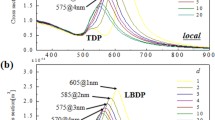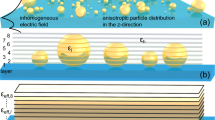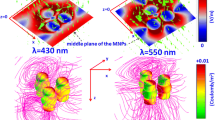Abstract
We investigate numerically the modification of the nonlinear optical properties of a nanoantenna in the trapping of nanoparticles (NPs) by using both the discrete dipole approximation method and the finite-difference time-domain technique. The nanoantenna, which is formed by two gold nanorods (GNRs) aligned end to end and separated by a small gap, can emit strong two-photon-induced luminescence (TPL) under the excitation of a femtosecond laser light which is resonant with its longitudinal surface plasmon resonance. In addition, the excited antenna can stably trap small NPs which in turn induce modifications in the emitted TPL. These two features make it a promising candidate for building highly sensitive detectors for NPs of different materials and sizes. It is demonstrated that sensors built with antennas possess higher sensitivities than those built with single GNRs and nanorod-based antennas are more sensitive than nanoprism-based antennas. In addition, it is found that the trapping probability for a second NP is significantly reduced for the antenna with a trapped NP, implying that trapping of NPs may occur sequentially. A relationship between the TPL of the system (antenna + NP) and the optical potential energy of the NP is established, enabling the extraction of the information on the optical potential energy and optical force by recording the TPL of the system. It is shown that the sequential trapping and releasing of NPs flowing in a microfluid channel can be realized by designing two different antennas arranged closely.










Similar content being viewed by others
References
Prasad PN (2004) Nanophotonics. John Wiley & Sons, New York
Mohamed MB, Volkov V, Link S, El-Sayed MA (2000) The ‘lightning’ gold nanorods: fluorescence enhancement of over a million compared to the gold metal. Chem Phys Lett 317:517–523
Chon JWM, Bullen C, Zijlstra P, Gu M (2007) Spectral encoding on gold nanorods doped in a silica sol-gel matrix and its application to high-density optical data storage. Adv Funct Mater 17:875–880
Zijlstra P, Chon JWM, Gu M (2009) Five-dimensional optical recording mediated by surface plasmons in gold nanorods. Nature 459:410–413
Li X, Lan TH, Tien CH, Gu M (2012) Three-dimensional orientation-unlimited polarization encryption by a single optically configured vectorial beam. Nat Commun 3:998
Link S, Mohamed MB, El-Sayed MA (1999) Simulation of the optical absorption spectra of gold nanorods as a function of their aspect ratio and the effect of the medium dielectric constant. J Phys Chem B 103:3073–3077
Chen L, Li GC, Liu GY, Dai QF, Lan S, Tie SL, Deng HD (2013) Sensing the moving direction, position, size, and material type of nanoparticles with the two-photon-induced luminescence of a single gold nanorod. J Phys Chem C 117:20146–20153
Lu G, Hou L, Zhang T, Li W, Liu J, Perriat P, Gong Q (2011) Anisotropic plasmonic sensing of individual or coupled gold nanorods. J Phys Chem C 115:22877–22885
Zijlstra P, Paulo PMR, Orrit M (2012) Optical detection of single non-absorbing molecules using the surface plasmon resonance of a gold nanorod. Nat Nanotechnol 7:379–382
Shao L, Fang C, Chen H, Man YC, Wang J, Lin HQ (2012) Distinct plasmonic manifestation on gold nanorods induced by the spatial perturbation of small gold nanospheres. Nano Lett 12:1424–1430
Nie S, Emory SR (1997) Probing single molecules and single nanoparticles by surface-enhanced raman scattering. Science 275:1102–1106
Huang X, El-Sayed IH, Qian W, El-Sayed MA (2007) Cancer cells assemble and align gold nanorods conjugated to antibodies to produce highly enhanced, sharp, and polarized surface raman spectra: a potential cancer diagnostic marker. Nano Lett 7:1591–1597
Nikoobakht B, El-Sayed MA (2003) Surface-enhanced Raman scattering studies on aggregated gold nanorods. J Phys Chem A 107:3372–3378
Bouhelier A, Bachelot R, Lerondel G, Kostcheev S, Royer P, Wiederrecht GP (2005) Surface plasmon characteristics of tunable photoluminescence in single gold nanorods. Phys Rev Lett 95:267405
Qiu L, Larson TA, Smith D, Vitkin E, Modell MD (2008) Observation of plasmon line broadening in single gold nanorods. Appl Phys Lett 93:153106
Liu M, Pelton M, Guyot-Sionnest P (2009) Reduced damping of surface plasmons at low temperatures. Phys Rev B 79:035418
Deng HD, Li GC, Dai QF, Ouyang M, Lan S, Trofimov VA, Lysak TM (2013) Size dependent competition between second harmonic generation and two-photon luminescence observed in gold nanoparticles. Nanotechnology 24:075201
Ni W, Kou X, Yang Z, Wang J (2008) Tailoring longitudinal surface plasmon wavelengths, scattering and absorption cross sections of gold nanorods. ACS Nano 2:677–686
Ohlinger A, Deak A, Lutich AA, Feldmann J (2012) Optically trapped gold nanoparticle enables listening at the microscale. Phys Rev Lett 108:018101
Hubert C, Billot L, Adam PM, Bachelot R, Royer P, Grand J, Gindre D, Dorkenoo KD, Fort A (2008) Role of surface plasmon in second harmonic generation from gold nanorods. Appl Phys Lett 93:153106
Butet J, Thyagarajan K, Martin OJ (2013) Ultrasensitive optical shape characterization of gold nanoantennas using second harmonic generation. Nano Lett 13:1787–1792
Wang H, Huff TB, Zweifel DA, He W, Low PS, Wei A, Cheng J (2005) In vitro and in vivo two-photon luminescence imaging of single gold nanorods. Proc Natl Acad Sci U S A 102:15752–15756
Imura K, Nagahara T, Okamoto H (2005) Near-field two-photon-induced photoluminescence from single gold nanorods and imaging of plasmon modes. J Phys Chem B 109:13214–13220
Volpe G, Noack M, Aćimović SS, Reinhardt C, Quidant R (2012) Near-field mapping of plasmonic antennas by multiphoton absorption in poly (methyl methacrylate). Nano Lett 12:4864–4868
Schwartz O, Oron D (2009) Background-free third harmonic imaging of gold nanorods. Nano Lett 9:4093–4097
Mühlschlegel P, Eisler H-J, Martin OJF, Hecht B, Pohl DW (2005) Resonant optical antennas. Science 308:1607–1609
Zhang W, Huang L, Santschi C, Martin OJF (2010) Trapping and sensing 10 nm metal nanoparticles using plasmonic dipole antennas. Nano Lett 10:1006–1011
Juan ML, Righini M, Quidant R (2011) Plasmon nano-optical tweezers. Nat Photon 5:349–356
Yurkin MA, Hoekstra AG (2007) The discrete dipole approximation: an overview and recent developments. J Quant Spectro Ra 106:546–557
Draine BT, Flatau PJ (2010) User guide for the discrete dipole approximation code DDSCAT 7. 1. arXiv: 1002. 1505
Yee K (1966) Numerical solution of initial boundary value problems involving Maxwell’s equations in isotropic media. IEEE Transactions on 14:302–307
Taflove A, Hagness SC (2005) Computational electrodynamics the finite-difference time-domain method, 3rd edn. Artech House, Boston, MA
Taflove A (1988) Review of the formulation and applications of the finite-difference time-domain method for numerical modeling of electromagnetic wave interactions with arbitrary structures. Wave Motion 10:547–582
Novotny L (2001) Forces in optical near-fields. In near-field optics and surface plasmon polaritons. Springer Berlin Heidelberg, Berlin, pp 123–141
Jain PK, Lee KS, El-Sayed IH, El-Sayed MA (2006) Calculated absorption and scattering properties of gold nanoparticles of different size, shape, and composition: applications in biological imaging and biomedicine. J Phys Chem B 110:7238–7248
Acknowledgments
The authors acknowledge the financial support from the National Natural Science Foundation of China (Grant Nos. 51171066 and 11374109), the Ministry of Education of China (Grant No. 20114407110002), and the project for high-level professionals in the universities of Guangdong province, China. Q.-F. Dai would like to thank the Guangzhou science and technology project (Grant No. 2011J2200080).
Author information
Authors and Affiliations
Corresponding author
Rights and permissions
About this article
Cite this article
Huang, Z., Dai, Q., Lan, S. et al. Numerical study of nanoparticle sensors based on the detection of the two-photon-induced luminescence of gold nanorod antennas. Plasmonics 9, 1491–1500 (2014). https://doi.org/10.1007/s11468-014-9768-2
Received:
Accepted:
Published:
Issue Date:
DOI: https://doi.org/10.1007/s11468-014-9768-2




